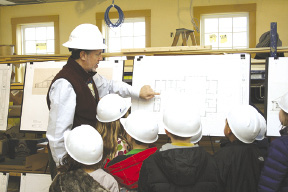Recently Derby Academy, an independent coeducational school serving pre-kindergarten through 8th grade, held the opening of their new Innovation Center. When construction was near completion, the school hosted an educational "hard hat" tour for students of their new building.
Students of all ages visited the construction site. They wore construction hats to go through the then almost-completed building. Educators worked with representatives of the architectural firm Olson Lewis + Architects and construction firm C.E. Floyd Company to create an interactive experience for all ages. They demonstrated connections between the skills students learn in the classroom with lessons put to work in the real world.
For the five months of construction, Derby Academy students have witnessed the development of the school's Innovation Center, from when the foundation was poured to near-completion. Appealing to children's natural curiosity about their surroundings, designers and builders developed age- and curriculum-appropriate exercises for all students participating in the "interactive tours." Presenters included Chris Doktor, a principal at Olson Lewis + Architects, and Chris Floyd, vice president of C.E. Floyd Company.
One student summed up the day when she said, "It was like a big puzzle. We played with the different parts of the building and figured out ways they could go together. When you put them together in different ways, they make something new. I want to do that when I grow up."
Each presentation included two parts. First they shared the project overview, which this communicated the 'life cycle' or progressive stages of how Derby Academy's Innovation Center developed from concept to construction. The students were led, step-by-step, through its evolution. They started with initial sketch ideas and moved to detailed documents such as floor plans, elevations, construction drawings (blueprints), engineering drawings, shop drawings, and 3D renderings.
The second part of the presentation took a more focused and interactive look at specific elements of the then almost-completed structure. Hands-on demonstrations with a scale mock-up of a truss showed how the building elements perform to create a complete structure.
One faculty member said, "Exercises like this 'hard hat' tour allow students to make connections between abstract ideas and their immediate physical world. Concepts come to life in their hands and their minds."
* For instance, first graders, who have been studying angles in class, took a closer look at the shape of the ornamental trusses in the building's "Project Room." Doktor explained how the truss, shown in an elevation drawing, is made of several triangles. Floyd shared a wooden 3-foot scale model, in which students found and counted the total number of triangles. Floyd also introduced a custom-made jigsaw puzzle of the truss and worked with students to reconstruct the triangular shape from various pieces.
* By contrast, fifth graders had been using the Fibonacci sequence to create a quilt in art class. For these students, Doktor used the Innovation Center's floor plan to demonstrate how the building's footprint was designed using the Golden Ratio, a proportional expression of the Fibonacci Sequence.
* Derby's sixth and seventh graders are currently studying urban planning and engineering. Some of these students are using the 'West Point Bridge Designer' software to participate in the 'Engineering Encounters Bridge Design Contest." Thus they received information from a more technological point of view. They have studied physics concepts such as force, tension / compression, live / static loads, as well as trusses. With the assistance of construction drawings and the scale model of the truss, discussions centered on load bearing beams and load calculations.
After the 'hard hat' tour, Innovation Center architect Chris Doktor said, "It's stimulating for us, as designers, to be among students as they engage a new learning environment. When they gain a greater understanding of their immediate surroundings, their curiosity leads to more questions and further investigation. They're never done learning, and neither are we."
Floyd said, "It was a lot of fun to connect Derby Academy's curriculum to the technical principals applied while building the Innovation Center. The evident curiosity and interest in construction was inspiring."
Tags:
Derby Academy hosts an educational "hard hat" tour for students of their new building
April 17, 2014 - Front Section









